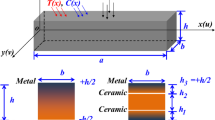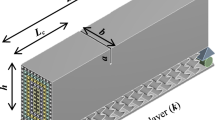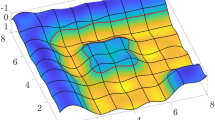Abstract
The polynomial representation for describing the displacement field of the elements is the main factor that determines the performance of the shear deformable beam elements based on the absolute nodal coordinate formulation (ANCF). In order to resolve the locking problem of the ANCF beam elements, the transversally higher-order polynomial representation has been investigated frequently and applied to the displacement field of the elements by increasing the nodal coordinates of the beam elements. In this paper, transversally higher-order interpolating polynomials are added into the polynomial displacement field of the elements by using common coefficients which mean that the coefficients between the higher-order longitudinal and transversal polynomial components are common. The implementation does not require the increase of the nodal coordinates. Two new kinds of two-dimensional transversally higher-order ANCF beam elements are formulated by common coefficients. The effect of transversally higher-order interpolating polynomials on the performance of the proposed ANCF beam elements is studied by means of certain static and dynamic problems. It is shown that the transversally quadratic order polynomial component \(y^{2}\) introduced by common coefficients can also relieve the problem of Poisson locking, and the proposed beam elements are effective and accurate in the static and dynamic analysis.



















Similar content being viewed by others
References
Shabana, A.A.: Definition of the slopes and the finite element absolute nodal coordinate formulation. Multibody Syst. Dyn. 1(3), 339–348 (1997)
Berzeri, M., Shabana, A.A.: Development of simple models for the elastic forces in the absolute nodal coordinate formulation. J. Sound Vib. 235(4), 539–565 (2000)
Berzeri, M., Campanelli, M., Shabana, A.A.: Definition of the elastic forces in the finite-element absolute nodal coordinate formulation and the floating frame of reference formulation. Multibody Syst. Dyn. 5(1), 21–54 (2001)
Tian, Q., Zhang, Y.Q., Chen, L.P., Qin, G.: Advances in the absolute nodal coordinate method for the flexible multibody dynamics. Adv. Mech. 40(2), 189–193 (2010)
Gerstmayr, J., Sugiyama, H., Mikkola, A.M.: Review on the absolute nodal coordinate formulation for large deformation analysis of multibody systems. J. Comput. Nonlinear Dyn. 8(3), 031016 (2013)
Nachbagauer, K.: State of the art of ANCF elements regarding geometric description, interpolation strategies, definition of elastic forces, validation and the locking phenomenon in comparison with proposed beam finite elements. Arch. Comput. Methods Eng. 21(3), 293–319 (2014)
Sopanen, J.T., Mikkola, A.M.: Description of elastic forces in absolute nodal coordinate formulation. Nonlinear Dyn. 34(1–2), 53–74 (2003)
Gerstmayr, J., Matikainen, M.K., Mikkola, A.M.: A geometrically exact beam element based on the absolute nodal coordinate formulation. Multibody Syst. Dyn. 20(4), 359–384 (2008)
Nachbagauer, K., Pechstein, A.S., Irschik, H., Gerstmayr, J.: A new locking-free formulation for planar, shear deformable, linear and quadratic beam finite elements based on the absolute nodal coordinate formulation. Multibody Syst. Dyn. 26(3), 245–263 (2011)
Nachbagauer, K., Gruber, P., Gerstmayr, J.: Structural and continuum mechanics approaches for a 3D shear deformable ANCF beam finite element: application to static and linearized dynamic examples. J. Comput. Nonlinear Dyn. 8(2), 021004 (2013)
Nachbagauer, K., Gerstmayr, J.: Structural and continuum mechanics approaches for a 3D shear deformable ANCF beam finite element: application to buckling and nonlinear dynamic examples. J. Comput. Nonlinear Dyn. 9(1), 011013 (2014)
Zhang, X.S., Zhang, D.G., Chen, S.J., Hong, J.Z.: Several dynamic models of a large deformation flexible beam based on the absolute nodal coordinate formulation. Acta Phys. Sin. 65(9), 094501 (2016)
Zhang, D.Y., Luo, J.J., Zheng, Y.H., Yuan, J.P.: Analysis of planar shear deformable beam using rotation field curvature formulation. Acta Phys. Sin. 66(11), 114501 (2017)
Zheng, Y.H., Shabana, A.A., Zhang, D.Y.: Curvature expressions for the large displacement analysis of planar beam motions. J. Comput. Nonlinear Dyn. 13(1), 011013 (2018)
Romero, I.: A comparison of finite elements for nonlinear beams: the absolute nodal coordinate and geometrically exact formulations. Multibody Syst. Dyn. 20(1), 51–68 (2008)
Patel, M., Shabana, A.A.: Locking alleviation in the large displacement analysis of beam elements: the strain split method. Acta Mech. 229(7), 2923–2946 (2018)
Shabana, A.A., Patel, M.: Coupling between shear and bending in the analysis of beam problems: planar case. J. Sound Vib. 419(2018), 510–525 (2018)
Omar, M., Shabana, A.A.: A two-dimensional shear deformable beam for large rotation and deformation problems. J. Sound Vib. 243(3), 565–576 (2001)
Kerkkänen, K.S., Sopanen, J.T., Mikkola, A.M.: A linear beam finite element based on the absolute nodal coordinate formulation. ASME J. Mech. Des. 127(4), 621–630 (2005)
Garcia-Vallejo, D., Mikkola, A.M., Escalona, J.L.: A new locking-free shear deformable finite element based on absolute nodal coordinates. Nonlinear Dyn. 50(1–2), 249–264 (2007)
Li, P.F., Gantoi, F.M., Shabana, A.A.: Higher order representation of the beam cross section deformation in large displacement finite element analysis. J. Sound Vib. 330(26), 6495–6508 (2011)
Shabana, A.A., Yakoub, R.Y.: Three dimensional absolute nodal coordinate formulation for beam elements: theory. ASME J. Mech. Des. 123(4), 606–613 (2001)
Yakoub, R.Y., Shabana, A.A.: Three dimensional absolute nodal coordinate formulation for beam elements: implementation and applications. ASME J. Mech. Des. 123(4), 614–621 (2001)
Gerstmayr, J., Matikainen, M.K.: Analysis of stress and strain in the absolute nodal coordinate formulation. Mech. Based Des. Struct. Mach. 34(4), 409–430 (2006)
Gerstmayr, J., Shabana, A.A.: Analysis of thin beams and cables using the absolute nodal coordinate formulation. Nonlinear Dyn. 45(1–2), 109–130 (2006)
Shen, Z.X., Li, P., Liu, C., Hu, G.K.: A finite element beam model including cross-section distortion in the absolute nodal coordinate formulation. Nonlinear Dyn. 77(3), 1019–1033 (2014)
Grzegorz, O., Shabana, A.A.: Analysis of warping deformation modes using higher order ANCF beam element. J. Sound Vib. 363(2016), 428–445 (2016)
Henrik, E., Matikainen, M.K., Hurskainen, V.V., Mikkola, A.M.: Higher-order beam elements based on the absolute nodal coordinate formulation for three-dimensional elasticity. Nonlinear Dyn. 88(2), 1075–1091 (2017)
Yu, H.D., Zhao, C.Z., Zheng, B., Wang, H.: A new higher-order locking-free beam element based on the absolute nodal coordinate formulation. J. Mech. Eng. Sci. 232(9), 3410–3423 (2017)
Acknowledgements
This work is supported by the grants from the National Natural Science Foundation of China (No. 51775328).
Author information
Authors and Affiliations
Corresponding author
Ethics declarations
Conflict of interest
The authors declare that they have no conflicts of interest concerning the publication of this manuscript.
Additional information
Publisher’s Note
Springer Nature remains neutral with regard to jurisdictional claims in published maps and institutional affiliations.
Rights and permissions
About this article
Cite this article
Zhao, C.H., Bao, K.W. & Tao, Y.L. Transversally higher-order interpolating polynomials for the two-dimensional shear deformable ANCF beam elements based on common coefficients. Multibody Syst Dyn 51, 475–495 (2021). https://doi.org/10.1007/s11044-020-09768-4
Received:
Accepted:
Published:
Issue Date:
DOI: https://doi.org/10.1007/s11044-020-09768-4




